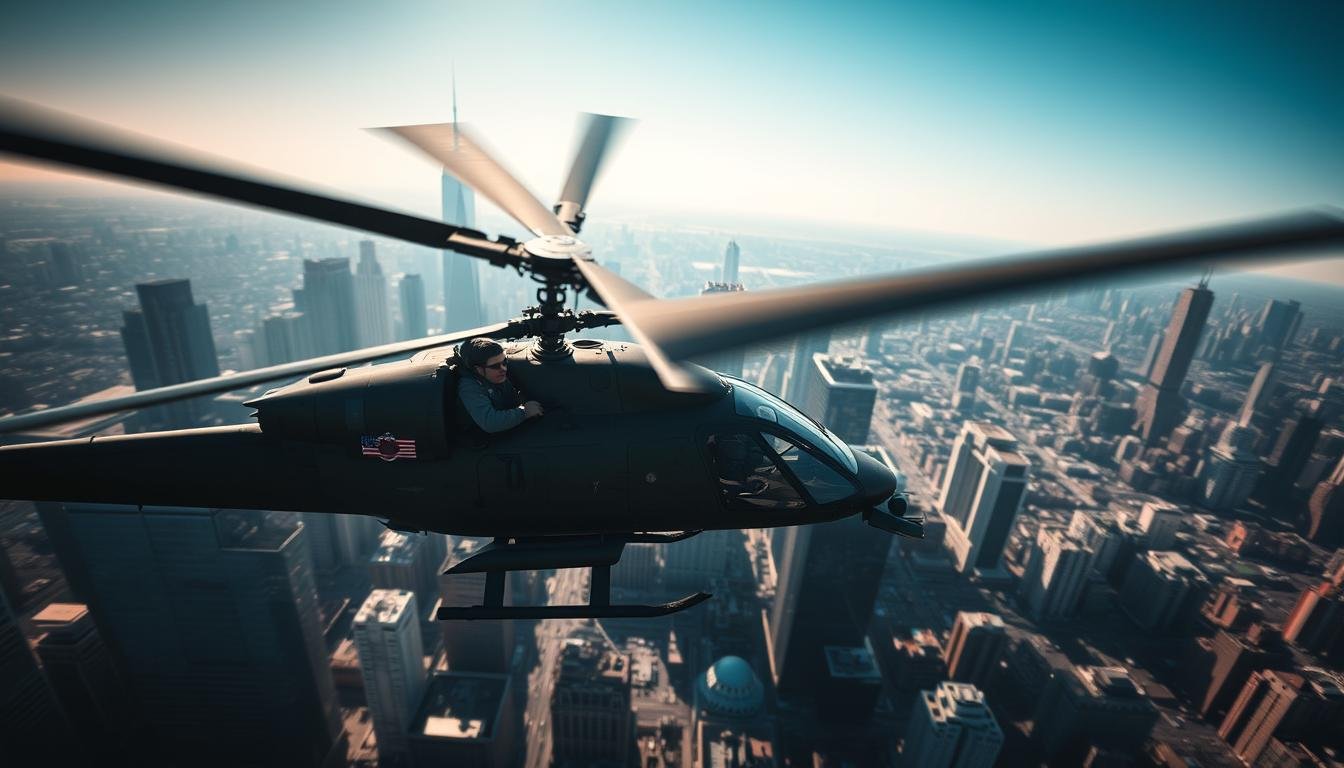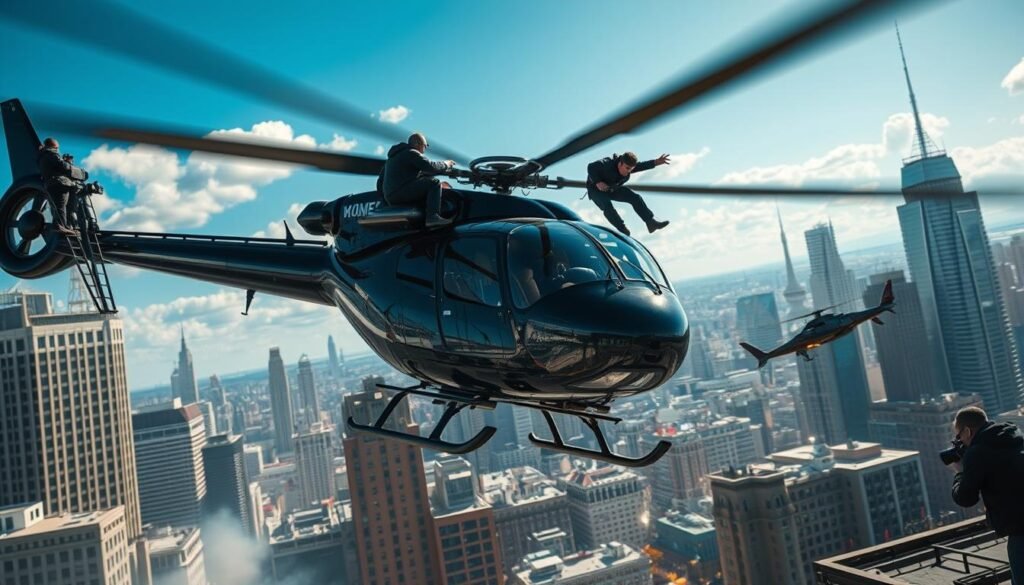Top Helicopter Movie Scenes: Iconic Action Moments from Blockbusters and War Films
“The more you sweat in peace, the less you bleed in war.” — Norman Schwarzkopf.
From Coppola’s operatic volleys to Stallone’s reckless gambits, certain aerial moments make a film unforgettable.
These pages highlight the exact beats when a rotor-driven set piece turns a scene into a cultural touchstone.
Readers will tour classics like Apocalypse Now’s “Ride of the Valkyries,” the Eurostar finale in Mission: Impossible, and adrenaline spikes from The Dark Knight to Rambo III.
The write-ups explain how sound, danger, and pure physics amplify each moment and why directors reused or reinvented those beats across a series and genres.
For a quick visual guide and broader roundup, see this curated best-of list and the compact picks at must-watch roundups.
Key Takeaways
- Iconic aerial moments fuse sound, danger, and choreography to define films.
- Directors use altitude and speed to raise stakes and create lasting images.
- Classic beats—from Ride of the Valkyries to urban chases—shaped later action set pieces.
- The list narrows each scene to why it mattered then and how it influenced others.
- Readers can skim to find favorite moments or discover new films to watch.
Helicopter Movie Scenes: The Definitive Listicle Of Iconic Moments
Here is a tight catalogue of aerial showstoppers that turned propellers into plot devices and adrenaline into art.
Apocalypse Now: Kilgore’s air cavalry scores one of cinema’s most audacious set pieces. Wagner blares as gunships spray napalm and the line “I love the smell of napalm in the morning.” cements the sequence as ritualized war opera.
Rambo III: Stallone treats the chopper like a recurring boss. Arrows, point-blank fire, crashing wrecks and a tank-versus-rotor payoff stack until the finale feels gleefully absurd.
Live Free Or Die Hard / Die Hard 4.0: Traffic turns into a weapon and McClane launches a car into a hovering target, capped by his dry punch line that gets the crowd every time.
Mission: Impossible (1996): Ethan’s tether to the Eurostar, explosive gum on a windshield, and rotor teeth that stop inches from his neck make this a nerve‑tight set piece.
The Dark Knight, 28 Weeks Later, Blue Thunder, Broken Arrow, True Lies: Each film finds a new way to flip aerial danger—cable traps between buildings, blades dragged low through crowds, train rams through glass, slow‑motion fireballs, and rocket-driven surprises. Together, they make this list an education in how choppers shape spectacle.
Behind The Blades: Why Helicopter Scenes Hit Harder On Screen
Aerial set pieces hit harder when filmmakers treat altitude like a silent threat that can snap a moment into catastrophe.
Altitude And Anxiety explains how lift becomes a storytelling device. Rising off the ground adds instant stakes. One misjudged turn or a snapped cable turns control into chaos.
Altitude And Anxiety: How Choppers Turn Action Into Edge-Of-Seat Suspense
Directors use sound — the thwop of blades and turbine roar — to build dread before the first gunshot. That sonic drumroll makes viewers brace.
Examples prove the point: Mission: Impossible ties a craft to a train, multiplying danger with speed, suction, and blades that nearly shave the lead. The Dark Knight shows police aviation undone by a cable trap, turning urban order into sudden peril.

Creative Destruction: From EMPs To Train Rams And Tank Face-Offs
Filmmakers refresh the formula by adding unique threats. Broken Arrow drops an EMP. Blue Thunder brings a train. Rambo III pits a tank against rotors.
Those choices shift a chopper from hunter to hunted in a cut. Time limits — fuel, distance, countdowns — make every beat feel urgent. Viewers remember moments when blades act as savior one second and scythe the next.
Further reading:See how these set pieces reshaped the genre inhow helicopters revolutionized action.
| Film | Device | Cinematic Effect | Memorable Moment |
|---|---|---|---|
| Mission: Impossible (1996) | Tethered craft + train | Multiplied danger vectors; tunnel suction | Blades inches from the hero |
| Blue Thunder | Train collision | Urban scale destruction; improvisation | Downtown duel turned wreckage |
| Broken Arrow | EMP and mixed attacks | Modern tech vulnerability; unpredictability | Systems fail mid-battle |
| Rambo III / The Dark Knight | Tank vs. rotor / cable trap | David-vs-Goliath tension; city booby traps | Bow-and-arrow takedown / police downed |
From Blockbusters To War Films: Genre-Spanning Chopper Chaos
Action filmmakers have long used rotorcraft to turn calm skies into sudden, cinematic terror.
War And Grit: Apocalypse Now And Rambo III Redefine Aerial Assault
Apocalypse Now uses Wagner and massed flight to make air power feel ritual and relentless. Kilgore’s assault reads like an operatic barrage that rewrites the battlefield in a single, oppressive sequence.
Rambo III answers with four explosions, a bow-and-arrow kill, and a tank-versus-rotor “chicken” face-off that treats aerial combat as raw, physical spectacle.
Superheroes And Crime: The Dark Knight’s Tactical Tangle
The Dark Knight flips a police escort when Joker strings cables between buildings. One brutal trap turns a protective craft into a weapon against the convoy.
“I think you and I are destined to do this forever.” — Joker (paraphrased intent)
Popcorn Mayhem: Blue Thunder, Broken Arrow, And Mission: Impossible
Blue Thunder stages a downtown cat-and-mouse that ends with a train ramming a craft through glass and window panes.
Broken Arrow stacks EMPs, collisions, and incineration for a fireworks‑style payoff, while Mission: Impossible ties a craft to a train for a physics-bending finale.

- War films favor long, oppressive sequences; thrillers use sharp, tactical strikes.
- Directors borrow tricks—EMP, train ram—to refresh the grammar of aerial action.
Conclusion
A final sweep shows how a few airborne beats can define a film’s tone and a fan’s memory.
Apocalypse Now keeps Wagner and ritualized assault in the mind. Rambo III stacks four explosive takedowns that read like a revenge symphony. The car-launched takedown in Live Free Or Die Hard follows a tunnel ambush and the dry line about running out of bullets.
Mission: Impossible’s Eurostar tether, The Dark Knight’s cable trap, 28 Weeks Later’s blade-driven survival, Blue Thunder’s train ram, Broken Arrow’s EMP flair, and True Lies’ rocket finale each show a different way to raise stakes.
Consider this list a launch pad for rewatching favorites or finding a new one. For a handy recap of iconic moments, see this curated top-ten roundup.
FAQ
What makes the most memorable chopper action in films?
The best moments combine high stakes, tight choreography, and a vivid soundtrack. Big-name directors use low angles, close-ups on rotor blades, and tense music to sell danger. Practical effects and real aerial filming add a tactile feel that CGI often struggles to match.
Which films started the trend of jaw‑dropping aerial set pieces?
Francis Ford Coppola’s Vietnam epic set a new bar with long, stylized attack sequences. Later directors borrowed its scale but mixed in car stunts, tunnels, and gadgetry to keep audiences gasping. Classics from the ’80s and ’90s then pushed realism and spectacle even further.
How do filmmakers safely shoot low‑altitude chases and crashes?
They rely on experienced pilots, stunt coordinators, and strict rehearsals. Many shots use camera rigs, remote systems, and controlled pyrotechnics. When real aircraft are involved, safety zones and backup crews are mandatory to protect cast and crew.
Are those perilous tunnel and rooftop stunts real or CGI?
Often they’re a hybrid. Directors prefer practical stunts for authenticity, then enhance shots with digital touchups. Tunnels and rooftops might be built sets with real drops and practical wire work, while CGI cleans up background hazards and fills in sky replacements.
Which actors insisted on doing their own aerial work?
A few stars push for physical involvement to boost realism. When they do, productions increase safety measures and add stunt doubles for the riskiest beats. The result is often a tighter performance and more convincing closeups.
Do war films influence Hollywood action choreography?
Absolutely. Real combat tactics inform staging, camera movement, and pacing. Directors borrow military procedures to lend authenticity, then exaggerate them for drama—turning reconnaissance flights and strafing runs into set‑piece masterpieces.
Why do audiences love sequences where vehicles meet aircraft?
There’s a primal thrill in scale contrast: fragile cars or trains versus hulking aircraft. Collisions and near‑misses create clear jeopardy, and witty quips or character reactions lighten tension without deflating the danger.
How do sound and music shape aerial tension?
Sound design highlights rotor thumps, wind rush, and mechanical groans to place viewers inside the craft. Scores can lift a raid into operatic territory or strip a chase down to raw anxiety. The right track makes a strike feel inevitable and unforgettable.
Which technical terms should fans know when discussing these sequences?
Useful terms include rotor wash, low‑level flight, wire rigging, aerial plate, and gimbal mounts. Knowing them helps fans appreciate the craft behind a pulse‑pounding cut or a seamless cockpit transition.
Can modern visual effects fully replace practical aerial filming?
VFX have grown impressively, but many filmmakers still favor practical elements to capture unpredictable motion and real light. A balanced mix usually yields the most convincing and visceral result for viewers.ows, promising audiences new heights of excitement. Whether inspiring aspiring aviators or creating unforgettable movie moments, helicopters will undoubtedly remain a cornerstone of cinematic innovation.


